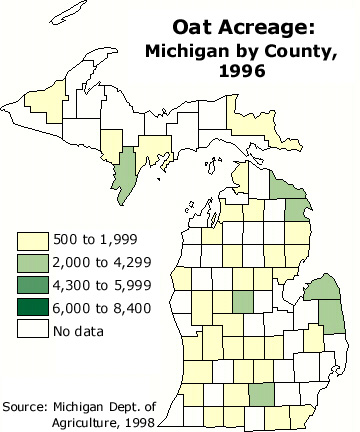OATS
Oats are used for animal feed and for human food. Oats were discovered thousands of years
ago in Egypt. They were once considered a weed and were sometimes used in medicines. The
crop became popular with farmers because it is easy to grow, harvest and feed to animals.
In the mid-1800s, oatmeal began to gain importance as a breakfast food. Since then, more
oat products have been developed and their nutritional qualities are popular among
health-conscious people. Like other small grain
crops, the oat plant is an annual grass which produces three to five hollow stems. The
stems have seed clusters or flowers on their branches. The plant grows two to three
feet tall under normal conditions.
Many producers choose to grow oats because they fit into most crop
rotations, do well on a wide range of soil types and help protect land from soil loss.
Major oat producing states are South Dakota, North Dakota, Iowa, Minnesota,
Wisconsin and Nebraska.
An important part of the cow's diet is small grains, which provide much
of the protein. For years, oats, shown below was one of the main grains fed to cows.
Today, farmers often buy much of their grain stuffs. Corn is also becoming a larger
and larger part of the diet of the "modern dairy cow".
Michigan’s 1993 oat production was 7.15 million bushels, down 15% from the previous
year. Late planting caused harvest to lag behind normal as the crop posted a 55 bushels
per acre yield, 15 bushels below 1992's average yield. Harvested acres increased 10,000
acres from 1992, to 130,000 acres. The average price per bushel in 1993 was $1.60,
virtually unchanged from the $1.63 a year earlier.


As can be seen from the map below, oats is a grain that is grown primarily where dairying is prominent (Wisconsin and New York), or on the northern Great Plains where small grains grow very well.

This material has been compiled for educational use only, and may not be reproduced without permission. One copy may be printed for personal use. Please contact Randall Schaetzl (soils@msu.edu) for more information or permissions.
